Multiplication in Excel empowers users to perform various calculations swiftly and accurately. Whether you’re multiplying numbers, calculating totals, or analyzing datasets, Excel’s multiplication function is indispensable. By mastering multiplication in Excel, you can streamline financial modeling, budgeting, and data analysis tasks. Harnessing Excel’s powerful features, including formulas, functions, and formatting options, ensures efficiency and precision in your calculations. With multiplication in Excel, users can handle complex computations effortlessly, saving time and enhancing productivity. Whether you’re a beginner or an advanced user, understanding and utilizing multiplication in Excel is essential for optimizing spreadsheet workflows and achieving your analytical goals.
This Tutorial Covers:
- Multiply in Excel by using the multiplication operator
- How to multiply numbers in Excel
- How to multiply cells in Excel
- How to multiply columns in Excel
- How to multiply rows in Excel
- Multiply function in Excel (PRODUCT)
- How to multiply by percentage in Excel
- How to do multiple a column by a number in Excel
- How to multiply and sum in Excel
- Multiplication in array formulas
- How to quickly do any calculations in Excel
1. Multiply in Excel by using the multiplication operator:
A simple method for performing the multiplication of numbers in Excel involves using the symbol (*) designated for multiplication. By utilizing this technique, you can easily multiply numbers, cells, and even entire rows or columns.
-
How to multiply numbers in Excel?
The simplest multiplication formula in Excel is created by entering the equals sign (=) in a cell, followed by the first number you wish to multiply, an asterisk, and the second number. The formula is then calculated by pressing the Enter key.
For instance, to multiple 10 by 6, enter the following formula in a cell (without any spaces):
=10*6
Excel allows conducting various arithmetic operations within one formula, as demonstrated in the screenshot below. Just keep in mind the PEMDAS sequence of operations: parentheses, exponentiation, multiplication, or division, depending on which comes first, and addition or subtraction, depending on which comes first.
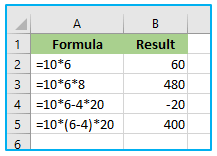
-
How to multiply cells in Excel?
Use a multiplication algorithm similar to the one in the example above, but substitute cell references for the numbers to multiply two cells in Excel. For instance, enter the following formula to increase the value in cell A2 by the value in cell B2:
=A2*B2
Add additional cell references to the formula, separating them with the multiplication sign, to multiply numerous cells. For instance:
=A2*B2*C2

-
How to multiply columns in Excel?
In Excel, enter the multiplication formula in cell E2 as follows to multiple two columns:
=C2*D2
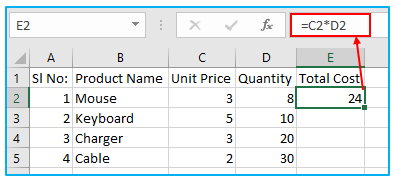
Double-click the tiny green square in the cell’s lower-right corner after entering the formula in the first cell (E2 in this case) to copy the formula down the column, up to the last cell containing data
The result looks like below:
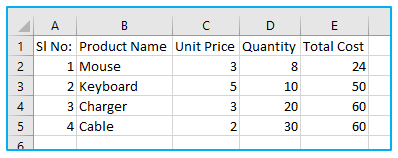
Our Excel multiply formula will correctly adjust for each row because it uses relative cell references (without the $ sign).
-
How to multiply rows in Excel?
Although it’s a less frequent job, multiplying rows in Excel also has a straightforward solution.
The steps to multiply two rows are described below:
Step 1: Put a multiplication formula in the first column, which is on the left.
In this instance, we multiply the values in row 1 by the values in row 2, starting with column B. This results in the following formula:
=B2*B3
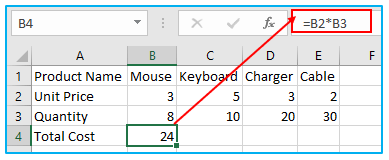
Step 2: Over the cells where you want to duplicate the formula, move black cross to the right.
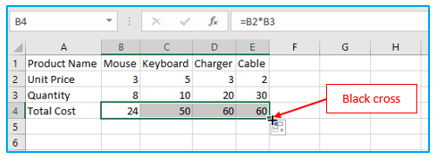
The relative cell references in the formula vary depending on the relative positions of the rows and columns, multiplying a value in row 1 by a value in row 2 in each column, just like when multiplying columns.
2. Multiply function in Excel (PRODUCT):
The PRODUCT function would be the quickest way to multiply multiple cells or ranges:
PRODUCT(number1, [number2], …)
If you want to multiply an integer, a set of cells, or a range, use the notation number1, number2, etc.
Use this formula, for instance, to multiply the numbers in cells A2, B2, and C2:
=PRODUCT(A2:C2)
Use this one to multiply the values in cells A2 through C2 and then to multiply the outcome by 7.
=PRODUCT(A2:C2,7)
These Excel multiplication formulas are displayed in the image below:

3. How to multiply by percentage in Excel?
In Excel, use the following multiplication algorithm to multiply percentages: Enter the equals symbol (=), the cell or number, the multiply (*) sign, and then the percentage.
Create a formula that is comparable to this:
- To multiple a number by a percentage: =200*30%
- To multiple a cell by a percentage: =A2*30%
- You can multiply by the equivalent decimal number in place of percentages. For instance, to multiply 200 by 30%, use the formula below understanding that 30% is equal to 30/100 (or 0.3): =200*0.3
All three statements produce the same outcome, as can be seen in the screenshot below:
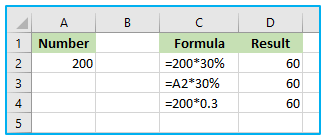
4. How to do multiple a column by a number in Excel?
Imagine you want to multiply a column of numbers by the same number in a dataset like the one below.
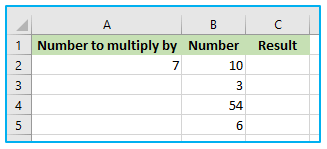
The steps to multiply a column of numbers by the same number are described below:
Step 1: Enter the following formula in cell C2:
=B2*$A$2
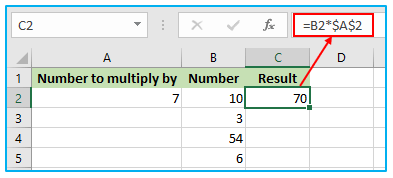
To avoid the reference from changing when you copy the formula to other cells, it’s crucial to lock the column and row coordinates of the cell with the multiplicand. In order to create an absolute reference ($A$2), type the $ symbol before the column letter and row number. Alternately, you can click the reference and hit F4 to make it absolute.
Step 2: To copy the formula down the column, double-click the fill handle in the formula cell (C2). Done!
As shown in the screenshot below, when the formula is transferred to row 3, C2 (relative reference) becomes C3, while $A$2 (absolute reference) stays the same.
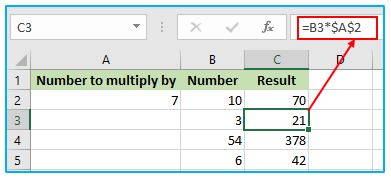
5. How to multiply and sum in Excel?
Use the SUMPRODUCT function to multiply the cells and add the results of individual computations when you need to multiply two columns or rows of numbers.
Let’s say you want to calculate the overall investment and you have the unit prices in column C and the quantity in column D. Each Price/Qty pair would be multiplied separately in your math lesson, and the subtotals would be added.
One formula in Microsoft Excel can be used to perform each of these calculations:
=SUMPRODUCT(C2:C5,D2:D5)
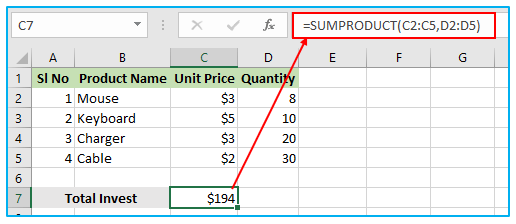
6. Multiplication in array formulas:
Do multiplication within an array formula if you want to multiply two columns of numbers and use the findings for additional calculations.
Another method for determining the total value of sales in the aforementioned data collection is as follows:
=SUM(C2:C5*D2:D5)
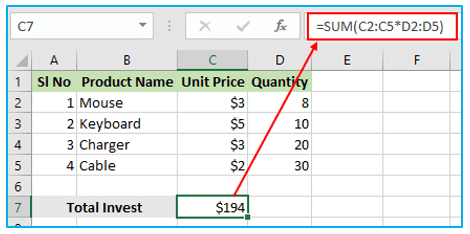
Similar to SUMPRODUCT, this Excel Sum Multiply algorithm yields the same outcome. (please see the screenshot earlier section).
Let’s continue the exercise by calculating the average invest. Simply substitutes the AVERAGE function for SUM in this case:
=SUM(C2:C5*D2:D5)
Utilize the MAX and MIN functions, respectively, to determine the highest and lowest invest:
=MAX(C2:C5*D2:D5)
Make careful to press Ctrl + Shift + Enter rather than just Enter to correctly complete an array formula. As soon as you do this, Excel will indicate that the formula is an array formula by enclosing it in “curly braces.”
This is how the outcomes might appear:
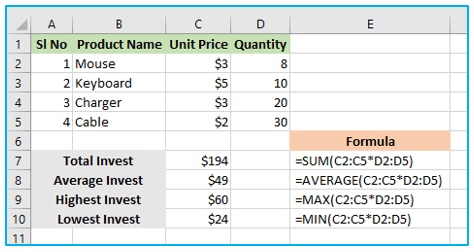
7. How to quickly do any calculations in Excel?
When working with Excel, it is important to be able to perform basic mathematical operations such as addition, subtraction, multiplication, and division. While the methods for performing each of these calculations are unique, there are some similarities between them that can make them easier to learn and understand.
For example, to perform multiplication in Excel, you can use a formula that multiplies two or more numbers together. You simply enter the appropriate values or cell references into the formula bar, separated by the asterisk (*) operator, and press Enter to calculate the result. Similarly, to perform addition, subtraction, or division, you can use formulas that incorporate the appropriate operators (+ for addition, – for subtraction, / for division) to combine the values or cell references you want to use.
Excel also provides built-in functions that can make it easier to perform these calculations. For example, the SUM function can be used to quickly add up a range of numbers, while the MINUS function can be used to subtract one number from another. The QUOTIENT function can be used to perform integer division, dividing one number by another, and returning the result as a whole number.
By understanding the similarities between the methods for performing these calculations in Excel, you can quickly and easily perform a wide range of mathematical operations in your spreadsheets. Whether you are working with simple calculations or complex data analysis, these tools can help you save time and work more efficiently.
Application of Multiplication in excel
- Basic multiplication: Excel’s multiplication operator () allows for straightforward multiplication of numbers in cells. For example, typing “=A1B1″ will multiply the values in cells A1 and B1.
- Multiplying arrays: Excel can handle arrays of numbers, making it easy to perform bulk calculations. By selecting a range of cells and using the multiplication operator, you can multiply corresponding elements in arrays.
- Calculating totals: Multiplication is often used to calculate totals in spreadsheets. Whether it’s calculating total sales revenue by multiplying price and quantity or determining total expenses by multiplying unit cost and quantity, Excel simplifies these tasks.
- Creating formulas: Multiplication is a fundamental component of creating formulas in Excel. Formulas often involve combining multiplication with other mathematical operators and functions to perform complex calculations.
- Financial modeling: In financial modeling, multiplication is used extensively to calculate projected revenues, expenses, profits, and other financial metrics. Excel’s flexibility in handling numerical data makes it ideal for financial modeling tasks.
- Statistical analysis: Multiplication plays a crucial role in statistical analysis, such as calculating weighted averages, variance, covariance, and other statistical measures. Excel’s built-in functions and capabilities support various statistical calculations involving multiplication.
For ready-to-use Dashboard Templates:
